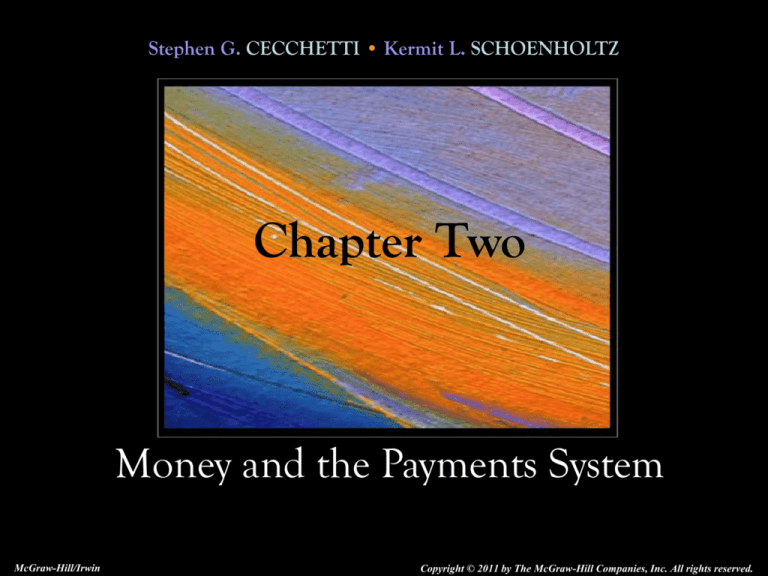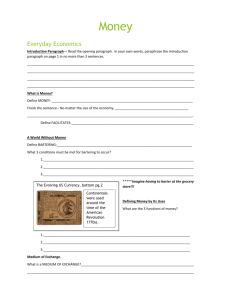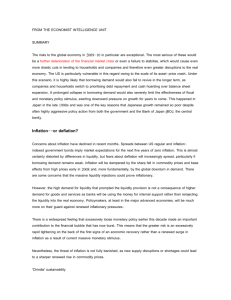
Stephen G. CECCHETTI • Kermit L. SCHOENHOLTZ
Chapter Two
Money and the Payments System
McGraw-Hill/Irwin
Copyright © 2011 by The McGraw-Hill Companies, Inc. All rights reserved.
Money and How We Use It
• Money is an asset that is generally accepted as
payment for goods and services or repayment
of debt.
• Income is a flow of earnings over time, where
wealth is the value of assets minus liabilities.
2-2
Money and How We Use It
Money has three characteristics:
1. It is a means of payment
2. It is a unit of account, and
3. It is a store of value.
The first of these characteristics is the most
important
2-3
Money and How We Use It
1. It is a means of payment
• People insist on payment in money.
•
•
Barter requires a “double coincidence of wants”.
Money is easier and finalizes payments so no
further claim on buyers and sellers.
2-4
Money and How We Use It
2. It is a unit of account.
• Money is used to quote prices and record
debts - it is a standard of value.
• Prices provide the information needed to
ensure resources are allocated to their best
uses.
• Using dollars makes relative price
comparisons easier.
2-5
Money and How We Use It
3. It is a store of value
• A means of payment has to be durable and
capable of transferring purchasing power
from one day to the next.
• Paper currency does degrade, but is accepted
at face value in transactions.
• Other forms of wealth are also a store of
value: stocks, bonds, houses, etc.
2-6
Money and How We Use It
3. Store of Value (cont.)
• Although other stores of value are sometimes
better than money, we hold money because it
is liquid.
• Liquidity is a measure of the ease with which
an asset can be turned into a means of
payment.
•
The more costly it is to convert an asset into
money, the less liquid it is.
2-7
Money and How We Use It
• It is a store of value (cont.)
• Financial institutions use:
• Market liquidity - the ability to sell assets for
money.
• Funding liquidity - ability to borrow money to buy
securities or make loans.
2-8
The Payments System
• The payments system is a web of arrangements
that allow for the exchange of goods and
services, as well as assets.
• It is critical this functions well.
• Money is at the heart of the payments system.
2-9
The Payments System
The possible methods of payment are:
1. Commodity and Fiat Monies
2. Checks
3. Electronic Payments
2-10
Commodity and Fiat Monies
• Commodity monies are things with intrinsic
value.
• Included items like silk and salt.
• To be successful, must be:
•
•
•
•
•
Usable by most people,
Able to be made into standardized quantities,
Durable,
Easily transportable, and
Divisible into smaller units.
2-11
Commodity and Fiat Monies
• Gold has been the most common as it meets
these requirements.
• In 1656, Stockholm Banco issued Europe's first
paper money
• King of Sweden printed too many to try to finance a
war and the bank failed.
• In 1775, the Continental Congress of the
United States of America issues “continentals”
to finance the Revolutionary War.
2-12
Commodity and Fiat Monies
• Because of huge quantities issued, people
became suspicious of government-issued paper
money.
• In 1862, the Confederate and the Union
governments printed money with no backing.
• After the Civil War, the US reverted to using
gold as money.
2-13
Commodity and Fiat Monies
• Gold coins and notes, backed by gold, were
used into the 20th century.
• Today’s paper money is called fiat money,
because its value comes from government
decree, or fiat.
• We are willing to accept these bills as payment
because the US government stands behind its
paper money.
• In the end, money is about trust.
2-14
Checks
• A check is an instruction to the bank to take
funds from your account and transfer them to
another account.
• A check is therefore not a final payment as currency
is.
• A check sets in motion a series of transactions
as seen in Figure 2.1.
2-15
Figure 2.1: The Path of a Paper
Check
2-16
Electronic Payments
• Electronic payments take the form of:
•
•
•
•
Credit and debit cards
Electronic funds transfers
Stored-value card
E-money
2-17
Electronic Payments
• Debit Cards
• Works like a check - tells the bank to transfer funds
from your account to another.
• Credit Cards
• A promise by a bank to lend the cardholder money
to make a purchase.
• They do not represent money.
2-18
Electronic Payments
• Electronic funds transfers
• Movements of funds directly from one account to
another.
• Most common form is the automated clearinghouse
transaction (ACH).
• Used for recurring payments like paychecks.
• Banks use electronic transfers for bank to bank
transactions, sending money through Fedwire.
2-19
Electronic Payments
• Stored-value card
• Take it to a bank or an ATM, transfer money to the
card, then use the card at a merchant.
• Limited usefulness so far.
• Limited in what can be purchased with them.
• Require specific hardware.
2-20
Electronic Payments
• E-money
• Can be used to pay for purchases on the Internet.
• You open an account by transferring funds to the
issuer of the e-money.
• When shopping online, you instruct the issuer to
send your e-money to the merchant.
• Really a form of private money.
2-21
The Future of Money
• The future of the three functions of money:
• Means of payment: disappearing due to ease of
electronic transactions.
• Unit of account: likely to remain.
• Will always be needed to quote values and
prices because it is efficient.
• But, will we move to one global unit of account?
• Store of value: disappearing due to liquidity of
many financial instruments.
2-22
Measuring Money
• Changes in the quantity of money are related to
• Interest Rates
• Economic Growth
• Inflation
2-23
Measuring Money
• Inflation:
• The process of prices rising.
• Inflation rate:
• The measurement of the process.
• With inflation, you need more money to buy
the same basket of goods.
• The primary cause of inflation is too much
money.
2-24
Measuring Money
• The value of the means of payment depends on
how much of it is circulating.
• We therefore must be able to measure how much is
circulating.
• Defining money means defining liquidity (see
figure 2.2).
2-25
Figure 2.2 - The Liquidity
Spectrum
2-26
Measuring Money
Different definitions of money are based upon degree of
liquidity.
Drawing the line in different places has led to several
measure of money called the money aggregates: M1
and M2.
M1: Narrowest definition.
Only the most liquid assets.
M2: Broader definition.
Includes assets not used as means of payment.
2-27
Table 2.1: The Monetary
Aggregates
2-28
Measuring Money
• What do the money aggregates mean?
• As of winter 2010, nominal US gross domestic
product (GDP) was $14,500 billion.
• Using the data in Table 2.1 above:
• GDP is nearly nine times as large as M1.
• GDP is about 70 percent larger than M2.
2-29
Measuring Money
• Which M do we use to understand inflation?
• Until the early 1980’s we used M1.
• But with changes in accounts, M2 became more
useful.
• M2 represents nearly one-half of GDP, so M1 is no
longer a useful measure of money.
• Figure 2.3 shows the M’s growth rates.
2-30
Figure 2.3: Growth Rates of the
Money Aggregates
2-31
Measuring Money
• How useful is M2 in tracking inflation?
• When the quantity of money grows quickly, it
produces high inflation.
• Figure 2.4 shows the inflation rate versus M2 two
years earlier for the US.
• Positive correlation up until 1980.
• From 1990-2000 - no correlation.
• Growth in M2 stopped being a useful tool for
forecasting inflation.
2-32
Figure 2.4: Money Growth and
Inflation
2-33
Measuring Money
• Why does M2 no longer predict inflation?
• Maybe the relationship only applies at high levels
of inflation.
• Maybe it only shows up over longer periods of
time.
• Maybe we need a new measure of money.
• We do know that at low levels of money
growth, inflation is likely to stay low.
2-34








